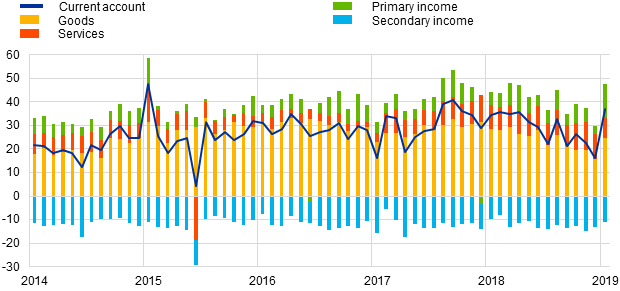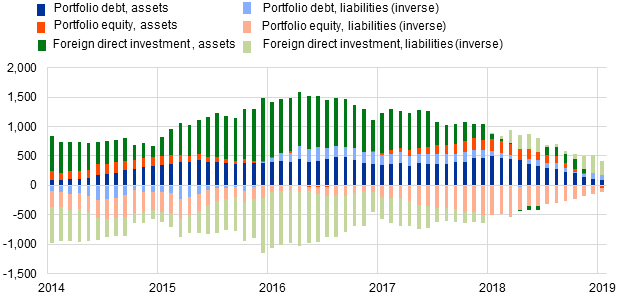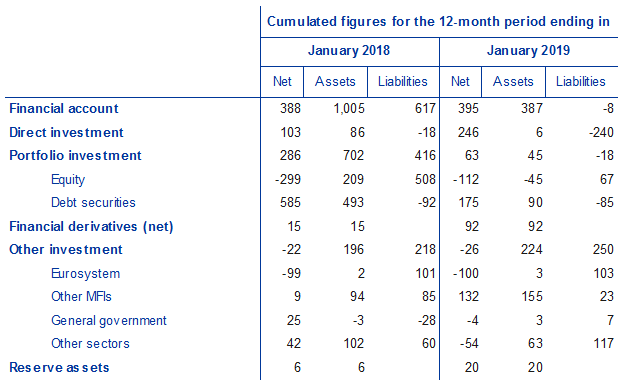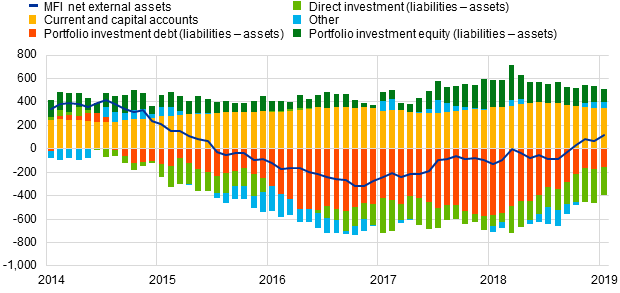- PRESS RELEASE
- 22 March 2019
Euro area monthly balance of payments: January 2019
- In January 2019 the current account of the euro area recorded a surplus of €37 billion, compared with a surplus of €16 billion in December 2018.[1]
- In the 12-month period to January 2019, the current account recorded a surplus of €345 billion (3.0% of euro area GDP), compared with a surplus of €380 billion (3.4% of euro area GDP) in the 12 months to January 2018.
- In the financial accounteuro area residents made net acquisitions of foreign portfolio investment securities totalling €45 billion in the 12-month period to January 2019 (decreasing from €702 billion in the 12 months to January 2018). Non-residents made net sales of euro area portfolio investment securities totalling €18 billion (following net purchases of €416 billion in the 12 months to January 2018).
Euro area current account balance
(EUR billions unless otherwise indicated; working day and seasonally adjusted data)

Source: ECB.
The current account of the euro area recorded a surplus of €37 billion in January 2019, increasing by €21 billion compared with December 2018 (see Chart 1 and Table 1). Surpluses were recorded for goods (€25 billion), services (€8 billion) and primary income (€15 billion). These were partly offset by a deficit for secondary income (€11 billion).
Current account of the euro area
(EUR billions unless otherwise indicated; transactions; working day and seasonally adjusted data)

Source: ECB.Note: Discrepancies between totals and their components may be due to rounding.
In the 12 months to January 2019, the current account recorded a surplus of €345 billion (3.0% of euro area GDP), compared with one of €380 billion (3.4% of euro area GDP) in the 12 months to January 2018. This decline was driven mainly by a smaller surplus for goods (down from €345 billion to €286 billion) and, to a lesser extent, by a larger deficit for secondary income (up from €140 billion to €148 billion). These developments were only partly offset by larger surpluses for services (up from €108 billion to €119 billion) and primary income (up from €67 billion to €89 billion).
Selected items of the euro area financial account
(EUR billions; 12-month cumulated data)

Source: ECB.Notes: For assets, a positive (negative) number indicates net purchases (sales) of non-euro area instruments by euro area investors. For liabilities, a positive (negative) number indicates net sales (purchases) of euro area instruments by non-euro area investors.
In direct investment, euro area residents’ net investments in non-euro area assets fell to €6 billion in the 12-month period to January 2019, down from €86 billion in the 12 months to January 2018 (see Chart 2 and Table 2). At the same time, non-residents’ net disinvestments in euro area assets increased to €240 billion, following net disinvestments of €18 billion in the 12-month period to January 2018.
In portfolio investment, net acquisitions of foreign debt securities by euro area residents decreased to €90 billion in the 12-month period to January 2019, a drop from €493 billion in the 12 months to January 2018. Over the same period, a shift was observed in the investment activity of euro area residents in foreign equity, with net purchases of €209 billion in the 12-month period to January 2018 being followed by net sales of €45 billion in the 12 months to January 2019. Non-residents’ net purchases of euro area equity fell to €67 billion in the 12 months to January 2019, down from a record high of €508 billion in the 12 months to January 2018. At the same time, their net sales of euro area debt securities declined slightly, falling from €92 billion in the 12-month period to January 2018 to €85 billion in the 12 months to January 2019.
Financial account of the euro area
(EUR billions unless otherwise indicated; transactions; non-working day and non-seasonally adjusted data)

Source: ECB.Notes: Decreases in assets and liabilities are shown with a minus sign. Net financial derivatives are reported under assets. “MFIs” stands for monetary financial institutions. Discrepancies between totals and their components may be due to rounding.
In other investment, euro area residents’ net acquisition of foreign assets increased to €224 billion in the 12 months to January 2019 (compared with €196 billion in the 12 months to January 2018), while their net incurrence of liabilities increased to €250 billion, up from €218 billion in the 12 months to January 2018.
Monetary presentation of the balance of payments
(EUR billions, 12-month cumulated data)

Source: ECB.Notes: MFI net external assets as reported in the consolidated MFI balance sheet items statistics. B.o.p. transactions refer only to transactions of non-MFI residents of the euro area. Financial transactions are shown as liabilities net of assets. “Other” includes financial derivatives, other investment and statistical discrepancies.
The monetary presentation of the balance of payments (see Chart 3) shows that the net external assets of euro area MFIs increased by €118 billion in the 12-month period to January 2019. This increase was driven mainly by the euro area’s current and capital accounts surplus and, to a lesser extent, by non‑MFIs’ net inflows in portfolio investment equity. This was partly offset by euro area non-MFIs’ net outflows in direct investment and portfolio investment debt securities.
In January 2019 the Eurosystem’s stock of reserve assets increased to €728.4 billion, up from €719.1 billion in the previous month (see Table 3). This increase of €9.3 billion was driven mainly by positive price changes (€11.0 billion) and, to a lesser extent, exchange rate changes (€0.8 billion), which were only partly offset by net sales of assets (€2.7 billion).
Reserve assets of the euro area
(EUR billions; amounts outstanding at the end of the period, flows during the period; non-working day and non-seasonally adjusted data)

Source: ECB.Note: “Other reserve assets” comprises currency and deposits, securities, financial derivatives (net) and other claims.
Data revisions
This press release does not incorporate revisions to previous periods.
Next press releases:
- quarterly balance of payments and international investment position: 4 April 2019 (reference data up to the fourth quarter of 2018)
- monthly balance of payments: 17 April 2019 (reference data up to February 2019)
For media queries, please contact Philippe Rispal, tel.: +49 69 1344 5482.
Notes
Hyperlinks in this press release lead to data that may change with subsequent releases as a result of revisions.
- [1]Current account data are always seasonally and working day-adjusted, unless otherwise indicated, whereas capital and financial account data are neither seasonally nor working day-adjusted.
Európska centrálna banka
Generálne riaditeľstvo pre komunikáciu
- Sonnemannstrasse 20
- 60314 Frankfurt nad Mohanom, Nemecko
- +49 69 1344 7455
- media@ecb.europa.eu
Šírenie je dovolené len s uvedením zdroja.
Kontakty pre médiá

